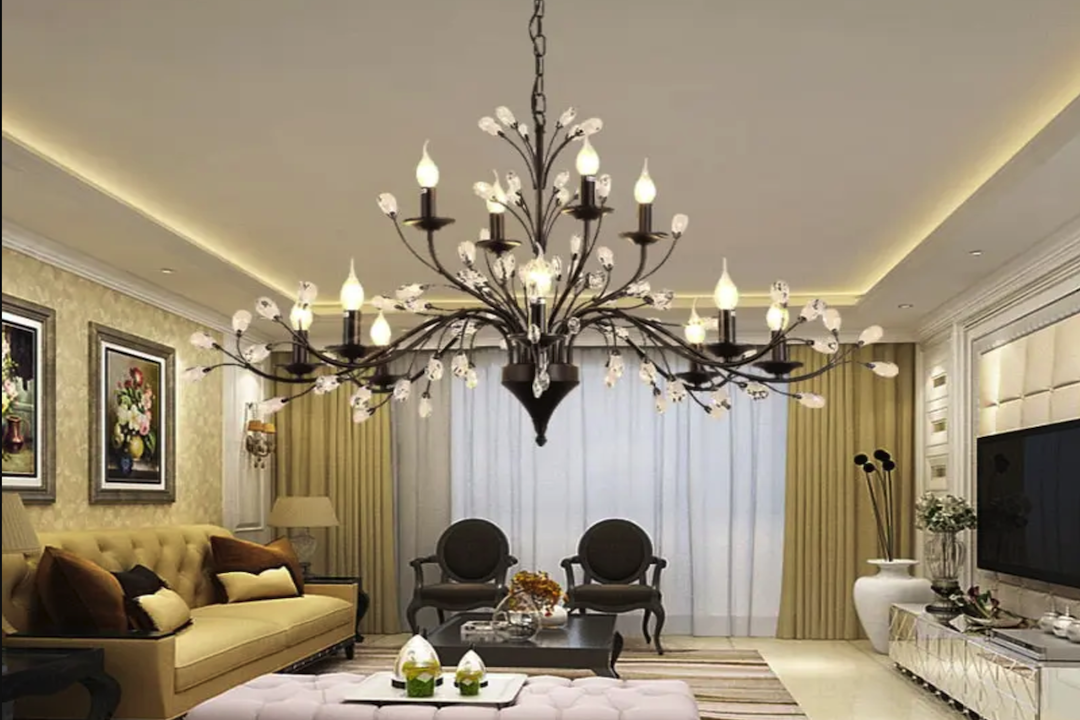The history of the iron chandelier is a fascinating journey that intertwines artistry, functionality, and the evolution of lighting technology. Originating in medieval Europe, chandeliers were initially crafted from wood and adorned with candles. These early designs were often simple and utilitarian, serving primarily to illuminate large spaces such as cathedrals and banquet halls.
As the demand for more elaborate lighting fixtures grew, artisans began experimenting with various materials, leading to the introduction of iron as a primary component. The durability and strength of iron made it an ideal choice for creating intricate designs that could support multiple light sources. By the Renaissance period, iron chandeliers had evolved significantly.
Blacksmiths and metalworkers began to showcase their skills by forging elaborate designs that featured scrollwork, floral motifs, and geometric patterns. These chandeliers Dkvdesign not only served a practical purpose but also became symbols of wealth and status. The use of wrought iron allowed for greater creativity, enabling artisans to craft pieces that were both functional and visually stunning.
As the centuries progressed, the industrial revolution further transformed chandelier production, making it possible to mass-produce intricate iron designs. This shift democratized access to decorative lighting, allowing more households to incorporate these beautiful fixtures into their homes.
The Versatility of Iron Chandeliers in Home Decor
Iron chandeliers are celebrated for their remarkable versatility, seamlessly fitting into a variety of design aesthetics. Whether one is aiming for a rustic farmhouse vibe or a sleek modern look, an iron chandelier can serve as a striking focal point that enhances the overall ambiance of a room. Their robust construction and diverse styles allow them to complement various materials and color palettes, making them an ideal choice for homeowners looking to create a cohesive design scheme.
For instance, in a contemporary setting, a minimalist iron chandelier with clean lines can add an industrial edge, while a more ornate design can evoke a sense of grandeur in traditional spaces. Moreover, the adaptability of iron chandeliers extends beyond mere aesthetics; they can also be functional in different settings. In dining rooms, an iron chandelier can provide ample illumination while serving as a conversation starter.
In entryways, it can create an inviting atmosphere that sets the tone for the rest of the home. Additionally, in outdoor spaces such as patios or gardens, weather-resistant iron chandeliers can enhance the outdoor experience by providing soft lighting during evening gatherings. This versatility makes iron chandeliers not just decorative elements but integral components of home decor that can elevate any space.
Choosing the Right Size and Style of Iron Chandelier for Your Space
Selecting the appropriate size and style of an iron chandelier is crucial to achieving a harmonious balance within a room. The dimensions of the chandelier should correspond to the scale of the space; a large chandelier in a small room can overwhelm the area, while a petite fixture in a grand hall may go unnoticed. A general guideline suggests that the diameter of the chandelier should be approximately one-half to two-thirds the width of the dining table or area it hangs above.
For instance, in a spacious dining room with high ceilings, a larger chandelier with multiple tiers can create a dramatic effect, drawing the eye upward and emphasizing the verticality of the space. In terms of style, it is essential to consider the existing decor and architectural features of the room. An ornate wrought iron chandelier with intricate detailing may be perfect for a traditional setting adorned with classic furnishings and rich fabrics.
Conversely, a sleek, minimalist design may be more suitable for modern or industrial spaces characterized by clean lines and neutral colors. Additionally, one should consider the finish of the iron; options range from matte black to brushed bronze or even distressed finishes that can add character and depth to the fixture. By thoughtfully selecting both size and style, homeowners can ensure that their iron chandelier enhances their space rather than detracting from it.
Maintenance and Care for Iron Chandeliers
Maintaining an iron chandelier is essential to preserving its beauty and functionality over time. Regular cleaning is necessary to prevent dust accumulation and tarnishing, which can dull its appearance. A simple solution involves using a soft cloth or feather duster to gently wipe down the fixture, ensuring that all crevices are attended to.
For more thorough cleaning, especially if the chandelier has intricate designs or crystals, it may be beneficial to use a mild soap solution and a soft brush to reach difficult areas. It is advisable to turn off the power supply before cleaning to ensure safety. In addition to regular cleaning, periodic inspections are crucial for maintaining an iron chandelier’s structural integrity.
Homeowners should check for loose screws or connections that may have come undone over time. If any bulbs are burnt out or flickering, they should be replaced promptly to maintain optimal lighting conditions. Furthermore, if the chandelier is located in an area prone to moisture or humidity, such as a bathroom or kitchen, applying a protective sealant can help prevent rusting and corrosion.
By adhering to these maintenance practices, homeowners can enjoy their iron chandeliers for years to come.
The Role of Iron Chandeliers in Interior Design
Iron chandeliers play a significant role in interior design by serving as both functional lighting sources and artistic statements. Their presence can dramatically alter the mood and atmosphere of a room, making them essential elements in creating cohesive design narratives. In many cases, an iron chandelier acts as a centerpiece around which other design elements are arranged.
For example, in a grand foyer, an oversized chandelier can draw attention upward while complementing architectural features such as vaulted ceilings or ornate moldings. Moreover, iron chandeliers can bridge different design styles within an open-concept space. For instance, in a home that combines rustic charm with modern elegance, an industrial-style iron chandelier can harmonize these contrasting elements by providing visual continuity.
This ability to unify disparate styles makes iron chandeliers invaluable tools for interior designers seeking to create balanced and inviting environments. Additionally, their adaptability allows them to be used in various settings—from formal dining rooms to cozy reading nooks—demonstrating their versatility as design elements.
Incorporating Iron Chandeliers in Different Rooms of the Home
The incorporation of iron chandeliers into various rooms of the home can enhance both functionality and aesthetic appeal. In dining areas, for instance, an iron chandelier can provide essential lighting while also serving as a decorative focal point above the table. The warm glow emitted by candles or bulbs within an iron fixture creates an inviting atmosphere conducive to gatherings and meals shared with family and friends.
Choosing a design that complements the dining table’s style—whether rustic farmhouse or sleek modern—can further enhance this effect. In living rooms, an iron chandelier can add character and sophistication while providing ambient lighting for relaxation or entertainment. Hanging one above a coffee table or seating area can create an intimate setting that encourages conversation.
Additionally, in bedrooms, smaller-scale iron chandeliers can serve as stylish alternatives to traditional bedside lamps, offering both illumination and decorative flair without taking up valuable surface space. By thoughtfully placing iron chandeliers throughout different rooms, homeowners can create cohesive lighting schemes that enhance their overall living experience.
The Timeless Appeal of Iron Chandeliers in Traditional and Modern Spaces
The timeless appeal of iron chandeliers lies in their ability to transcend fleeting design trends while remaining relevant across various styles and eras. In traditional spaces, these fixtures evoke a sense of history and craftsmanship that resonates with classic design principles. The intricate detailing often found in wrought iron designs complements ornate furnishings and rich textiles typical of traditional decor.
This enduring quality ensures that even as styles evolve, iron chandeliers maintain their status as coveted decorative elements. Conversely, in modern spaces characterized by minimalism and simplicity, iron chandeliers offer a striking contrast that adds depth and interest without overwhelming the aesthetic. Their raw materials and industrial finishes align well with contemporary design philosophies that celebrate authenticity and craftsmanship.
The juxtaposition of sleek lines with robust iron creates visual tension that enhances modern interiors while providing essential lighting solutions. This duality—being both timeless and adaptable—ensures that iron chandeliers will continue to be cherished fixtures in homes for generations to come.
The Future of Iron Chandeliers in Design Trends
As design trends continue to evolve, the future of iron chandeliers appears promising due to their inherent versatility and enduring appeal. With increasing interest in sustainable materials and artisanal craftsmanship, many designers are revisiting traditional techniques while incorporating modern innovations into their creations. This trend may lead to new interpretations of classic iron chandelier designs that blend historical elements with contemporary aesthetics.
Additionally, advancements in lighting technology are likely to influence how iron chandeliers are designed and utilized in homes. The integration of energy-efficient LED bulbs allows for more creative possibilities regarding size and shape without compromising on brightness or functionality. Furthermore, smart home technology may enable homeowners to control their chandeliers remotely or adjust lighting levels according to mood or occasion.
In conclusion, as we look ahead at design trends shaping our living spaces, it is clear that iron chandeliers will remain relevant fixtures that continue to inspire creativity and innovation within interior design.

